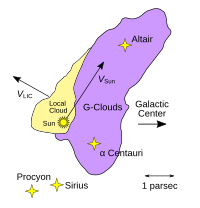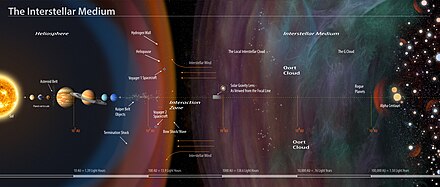Local Interstellar Cloud
| Interstellar cloud | |
|---|---|
 Diagram of surrounding stars and artist's conception of the Local Interstellar Cloud | |
| Observation data | |
| Constellation | None,Solar Systemis inside the nebula[1] |
| Physical characteristics | |
| Dimensions | 30ly(9.2pc) |
| Designations | Local Cloud, LIC |

TheLocal Interstellar Cloud(LIC), also known as theLocal Fluff,is aninterstellar cloudroughly 30light-years(9.2pc) across, through which theSolar Systemis moving. This feature overlaps with a region around the Sun referred to as thesolar neighborhood.[2]It is unknown whether theSunis embedded in the Local Interstellar Cloud, or is in the region where the Local Interstellar Cloud is interacting with the neighboringG-Cloud.[3]Like the G-Cloud and others, the LIC is part of theVery Local Interstellar Mediumwhich begins where theheliosphereandinterplanetary mediumend,[4]the furthest that probes have traveled.
Structure
[edit]The Solar System is located within a structure called theLocal Bubble,a low-density region of the galacticinterstellar medium.[5]Within this region is the Local Interstellar Cloud (LIC), an area of slightly higher hydrogen density. It is estimated that the Solar System entered the LIC within the past 10,000 years.[6] It is uncertain whether the Sun is still inside of the LIC or has already entered a transition zone between the LIC and the G cloud.[3][6][7] A recent analysis estimates the Sun will completely exit the LIC in no more than 1,900 years.[8]
The cloud has a temperature of about 7,000 K (7,000 °C; 12,000 °F),[9]about the same temperature as the surface of the Sun. However, itsspecific heat capacityis very low because it is not very dense, with 0.3 atoms per cubic centimetre (5/cu in). This is less dense than the average for the interstellar medium in theMilky Way(0.5/cm3or 8/cu in), though six times denser than the gas in the hot, low-density Local Bubble (0.05/cm3or 0.8/cu in) which surrounds the local cloud.[5][10]In comparison,Earth's atmosphereatthe edge of space(i.e. 100 km above sea level) has around 1.2×1013molecules per cubic centimeter, dropping to around 50 million (5.0×107) at 450 km (280 mi).[11]
The cloud is flowing outwards from theScorpius–Centaurus association,astellar associationthat is a star-forming region,[12][13]roughly perpendicular to the Sun's own direction, if assumed to be two dimensional.[clarification needed]
In 2019, researchers found interstellariron-60(60Fe) inAntarctica,which they relate to the Local Interstellar Cloud.[14]
Interaction with solar magnetic field
[edit]
In 2009,Voyager 2data suggested that the magnetic strength of the local interstellar medium was much stronger than expected (370 to 550picoteslas(pT), against previous estimates of 180 to 250 pT). The fact that the Local Interstellar Cloud is strongly magnetized could explain its continued existence despite the pressures exerted upon it by the winds that blew out the Local Bubble.[15]
The Local Interstellar Cloud's potential effects on Earth are greatly diminished by thesolar windand theSun's magnetic field.[9]This interaction with theheliosphereis under study by theInterstellar Boundary Explorer(IBEX), aNASAsatellite mapping the boundary between the Solar System and interstellar space.
See also
[edit]- Gould Belt
- List of nearest stars and brown dwarfs
- List of nearby stellar associations and moving groups
- Orion Arm
- Perseus Arm
- Voyager program– probes left heliosphere in the 2010s
References
[edit]- ^"NAME LIC".SIMBAD.Centre de données astronomiques de Strasbourg.RetrievedMarch 15,2014.
- ^Gargaud, Muriel; et al., eds. (2011)."Solar Neighborhood".Encyclopedia of Astrobiology.pp. 1526–1527.doi:10.1007/978-3-642-11274-4_1460.ISBN978-3-642-11271-3.Retrieved2022-07-01.
- ^abGilster, Paul (September 1, 2010)."Into the Interstellar Void".Centauri Dreams.
- ^Linsky, Jeffrey (2020-03-23), "What lies immediately outside of the heliosphere in the very local interstellar medium (VLISM): morphology of the Local Interstellar Cloud, its hydrogen hole, Stromgren Shells, and 60Fe accretion",Egu General Assembly Conference Abstracts,Copernicus GmbH: 1410,Bibcode:2020EGUGA..22.1410L,doi:10.5194/egusphere-egu2020-1410,S2CID226032795
- ^ab"Our Local Galactic Neighborhood".Interstellar Probe Project. NASA. 2000. Archived fromthe originalon 2013-11-21.Retrieved2012-08-08.
- ^ab Frisch PC, et al. (September 2011)."The Interstellar Medium Surrounding the Sun".Annual Review of Astronomy and Astrophysics.49(1): 252.Bibcode:2011ARA&A..49..237F.doi:10.1146/annurev-astro-081710-102613.Retrieved2021-12-28.
- ^ Linsky JL, et al. (November 18, 2019)."The Interface between the Outer Heliosphere and the Inner Local ISM".The Astrophysical Journal.886(1): 41.arXiv:1910.01243.Bibcode:2019ApJ...886...41L.doi:10.3847/1538-4357/ab498a.S2CID203642080.
- ^ Linsky JL, et al. (March 2020)."New results concerning the environment of the heliosphere, nearby interstellar clouds, and physical processes in the inter–cloud medium".Journal of Physics: Conference Series.1620(1): 012010.Bibcode:2020JPhCS1620a2010L.doi:10.1088/1742-6596/1620/1/012010.S2CID225188522.
- ^ab"Near-Earth Supernovas".NASA Science. NASA. January 6, 2003.RetrievedFebruary 1,2011.
- ^Boulanger, F.; et al. (2000). "Course 7: Dust in the Interstellar Medium". InCasoli, F.;Lequeux, J.; David, F. (eds.).Infrared Space Astronomy, Today and Tomorrow.Les Houches Physics School. Grenoble, France. August 3–28, 1998. Vol. 70. p. 251.Bibcode:2000isat.conf..251B.
- ^United States Committee on Extension to the Standard Atmosphere (October 1976).U.S. Standard Atmosphere, 1976.NOAA,NASAandU.S. Air Force.pp. 210–215.OCLC3360756.
- ^Nemiroff, R.; Bonnell, J., eds. (February 10, 2002)."The Local Interstellar Cloud".Astronomy Picture of the Day.NASA.RetrievedDecember 21,2016.
- ^Nemiroff, R.; Bonnell, J., eds. (February 17, 2002)."The Local Bubble and the Galactic Neighborhood".Astronomy Picture of the Day.NASA.RetrievedDecember 21,2016.
- ^Koll, Dominik; et al. (August 2019). "Interstellar60Fe in Antarctica ".Physical Review Letters.123(7). 072701.Bibcode:2019PhRvL.123g2701K.doi:10.1103/PhysRevLett.123.072701.hdl:1885/298253.PMID31491090.S2CID201868513.
- ^Opher, M.; et al. (December 24–31, 2009)."A strong, highly-tilted interstellar magnetic field near the Solar System"(PDF).Nature.462(7276): 1036–1038.Bibcode:2009Natur.462.1036O.doi:10.1038/nature08567.PMID20033043.S2CID205218936.
Further reading
[edit]- "A Breeze from the Stars"at NASA Science
- "Voyager Makes an Interstellar Discovery"at NASA Science
- "Local Chimney and Superbubbles"
- Anderson, Mark (January 6, 2007). "Don't stop till you get to the Fluff".New Scientist.193(2585): 26–30.doi:10.1016/S0262-4079(07)60043-8.
External links
[edit] Media related toLocal Interstellar Cloudat Wikimedia Commons
Media related toLocal Interstellar Cloudat Wikimedia Commons

